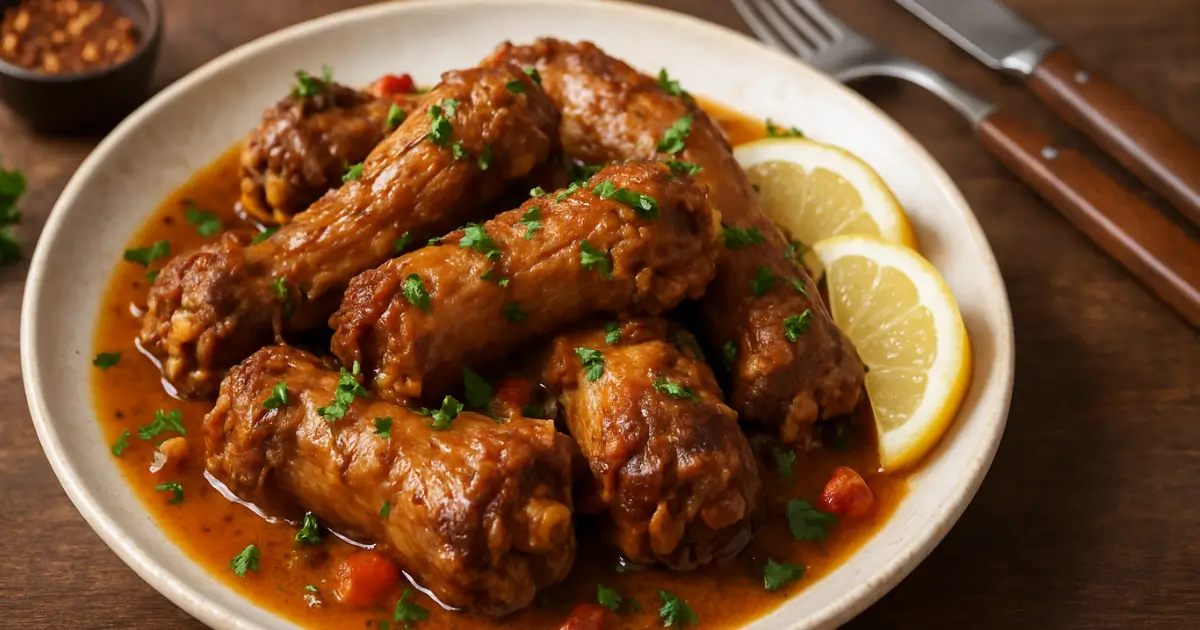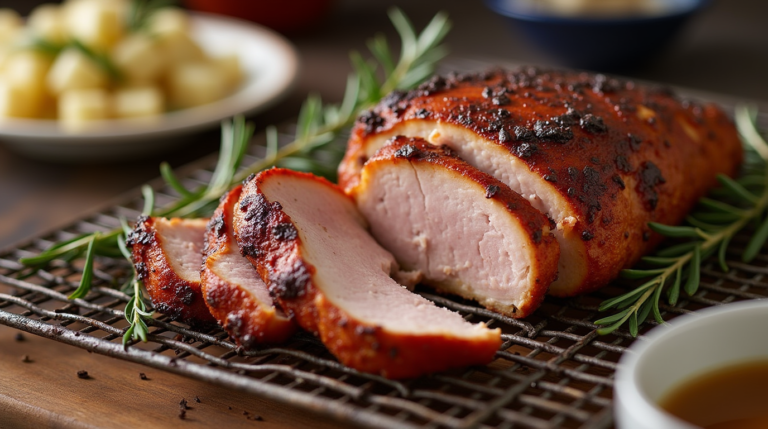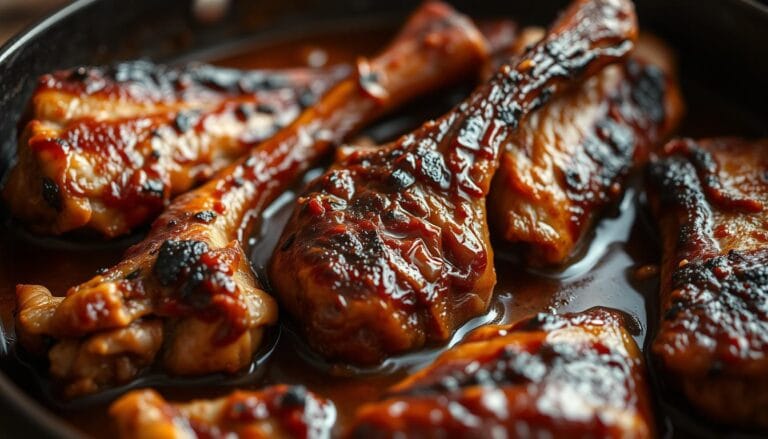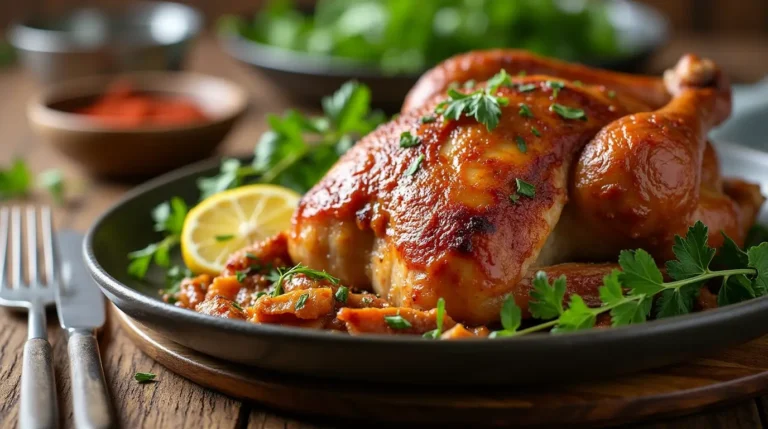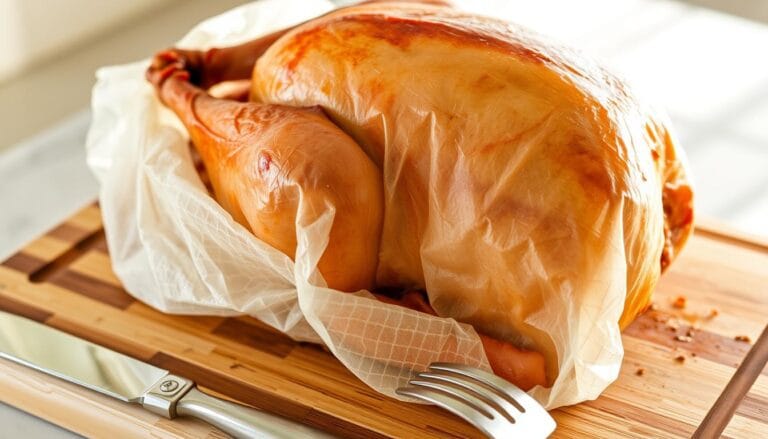The Turkey Neck Recipe: Classic Recipe for Flavorful Results
Growing up in a Ukrainian household, I learned early that every part of an animal deserves respect and has its rightful place on the dinner table. This philosophy shaped my appreciation for cuts that many Americans overlook or dismiss entirely. Among these forgotten treasures, turkey neck recipe hold a special place in my heart – and once you try this recipe, they’ll earn a spot in yours too.
I’ll be honest: when I first mention turkey necks to friends, I’m usually met with raised eyebrows and polite skepticism. Most people associate necks with pet food or something best left for the stock pot. But here’s what they don’t know – turkey necks are arguably the most flavorful, succulent part of the entire bird. When prepared correctly, they transform into fall-off-the-bone comfort food that rivals any premium cut.
My love affair with necks began in childhood with chicken necks, a common treat in Eastern European cooking. Years later, when I discovered turkey necks at my local butcher, I realized I’d found something even better – all that incredible flavor with significantly more meat. Today, I’m sharing the classic preparation method that’s been perfected through generations of home cooks who understood that the best parts of cooking often come from the most unexpected places.
Table of Contents
Why Turkey Neck Recipe Deserve Your Attention
Before we dive into the cooking process, let’s address the elephant in the room. Turkey necks might seem unconventional, but they’re actually one of the most underrated and underutilized cuts available. These bony segments contain an incredible concentration of flavor, thanks to the abundance of connective tissue, marrow, and dark meat that surrounds the vertebrae.
The neck region works hard during a turkey’s lifetime, which means more developed muscle fibers and richer taste. This also means more collagen, which breaks down during slow cooking to create that silky, luxurious texture that makes the meat practically melt in your mouth. When properly prepared, turkey necks deliver a dining experience that’s both rustic and refined – perfect for those cold winter evenings when you crave something deeply satisfying.
What makes this cut particularly appealing is its versatility and affordability. While premium cuts continue to rise in price, turkey necks remain accessible to budget-conscious families without sacrificing flavor or nutritional value. In fact, they’re packed with protein, essential minerals, and nutrients that make them a smart addition to any meal plan.
The Classic Preparation Method
The beauty of cooking turkey necks lies in its simplicity. This isn’t a complicated technique requiring specialized equipment or exotic ingredients. Instead, it relies on fundamental cooking principles that have stood the test of time. The process involves just two main steps: searing and slow roasting.
The method I’m sharing today combines the best of both worlds – the deep flavor development that comes from proper browning, followed by gentle oven cooking that transforms tough connective tissue into tender, succulent meat. This approach ensures that every bite delivers maximum flavor while maintaining the kind of texture that makes you close your eyes and savor the moment.
What sets this recipe apart from other preparation methods is the careful balance of moisture and heat. Too much moisture, and you’ll end up with boiled meat that lacks character. Too little, and the necks become tough and chewy. The technique I’ve perfected creates the ideal environment for breaking down tough fibers while preserving the rich, concentrated flavors that make turkey necks so special.
Essential Ingredients and Equipment
This recipe proves that exceptional results don’t require a long shopping list. You’ll need just a handful of quality ingredients: fresh turkey necks, aromatic vegetables, and basic seasonings. The star vegetables – carrots and onions – aren’t just flavor enhancers; they also contribute natural sugars that help create beautiful caramelization and depth.
Bay leaves play a crucial supporting role, adding subtle herbal notes that complement the rich turkey flavor without overwhelming it. The key is using fresh, high-quality bay leaves rather than the dusty ones that have been sitting in your spice cabinet for years. Fresh bay leaves release more essential oils, contributing significantly to the overall flavor profile.
For equipment, you’ll need a heavy-bottomed skillet for initial browning and an oven-safe pan for the roasting phase. Cast iron works exceptionally well because it retains and distributes heat evenly, but any heavy, oven-safe skillet will deliver excellent results. The most important factor is having enough space for the necks to brown properly without overcrowding.


Step-by-Step Cooking Process
The journey begins with optional preparation – cutting larger turkey necks into more manageable pieces. This step isn’t mandatory, but it can help with even cooking and easier serving. While you’re making this decision, take time to examine each piece, removing any obvious bone fragments or unwanted bits.
Next comes vegetable preparation. Dice your onion into half-rings rather than small pieces – this prevents them from disappearing during the long cooking process while still allowing them to contribute their sweetness and flavor. Carrots should be cut into substantial chunks that will hold their shape throughout the cooking time, adding both nutrition and visual appeal to the finished dish.
The browning phase is where the magic begins. Heat your skillet over medium-high heat with a light coating of olive oil. The goal is achieving deep, golden-brown color on all sides of each neck piece. This process takes patience – rushing will result in uneven browning and missed flavor opportunities. Each surface should develop a rich, caramelized exterior that will contribute significantly to the final taste.
After removing the browned necks, use the same skillet to cook your onions. This step captures all those beautiful browned bits (fond) left behind from the turkey necks, incorporating them into the vegetable base. Cook the onions until they’re lightly golden and softened, creating another layer of flavor that will permeate the entire dish.
The Secret to Perfect Tenderness
Here’s where many home cooks go wrong with turkey necks – they skip the moisture component. The secret to achieving that coveted fall-off-the-bone texture lies in adding exactly one cup of hot water to the skillet before it goes into the oven. This might seem counterintuitive if you’re used to dry-roasting methods, but it’s absolutely essential for this cut.
The added liquid creates a gentle steam environment inside your covered skillet, preventing the meat from becoming tough and rubbery. As the dish cooks, this moisture works together with the natural collagen in the necks to create a rich, flavorful braising liquid that becomes the foundation for an incredible gravy.
This technique essentially combines braising and roasting methods, giving you the best of both approaches. The initial searing provides flavor development, while the moist heat environment ensures tenderness. The result is meat that separates effortlessly from the bone while retaining all its natural juices and concentrated flavors.
Cooking Variations and Alternatives
While the classic oven method produces consistently excellent results, turkey necks adapt beautifully to other cooking techniques. Smoking represents one of the most popular alternatives, particularly for those who enjoy outdoor cooking. Pre-smoked turkey necks, available at many butcher shops, offer incredible convenience and make excellent additions to stews, chilis, and hearty soups.
For home smoking enthusiasts, setting your smoker to 180°F and cooking for two to four hours creates an entirely different flavor profile. The low, slow heat combined with wood smoke produces incredibly tender meat with complex, nuanced flavors that make an adventurous departure from traditional smoked poultry options.
Turkey neck soup deserves special mention as one of the most comforting applications for this cut. The long, gentle simmering required for soup-making breaks down every bit of connective tissue while creating a rich, nourishing broth that’s perfect for cold weather or when someone’s feeling under the weather. The resulting soup carries all the healing properties traditionally associated with chicken soup, but with even richer, more complex flavors.
Serving Suggestions and Pairings
The versatility of well-prepared turkey necks shines when it comes to serving options. Traditional pairings like mashed potatoes or white rice provide the perfect canvas for soaking up the rich, flavorful juices that develop during cooking. These starchy sides complement the intense flavors without competing for attention.
However, don’t overlook the simple pleasure of enjoying turkey necks straight from the oven on their own. There’s something deeply satisfying about picking up a perfectly cooked neck and savoring the tender meat directly from the bone – it’s primal, satisfying, and utterly delicious.
For those looking to elevate the experience, consider incorporating the cooking liquid into a proper gravy. The concentrated flavors and natural gelatin create an exceptional base that transforms simple sides into memorable components of the meal. This gravy pairs beautifully with roasted vegetables, potatoes, or even drizzled over the turkey necks themselves.
Where to Find Turkey Necks
Sourcing turkey necks can sometimes present a challenge, as not every grocery store carries them regularly. Large supermarkets with full-service meat departments typically stock them, especially during holiday seasons when whole turkeys are processed more frequently. Building a relationship with local butchers often provides the most reliable access, as they can often order necks specifically for you or save them when processing whole birds.
Many people don’t realize that turkey necks freeze exceptionally well, so when you find them available, consider purchasing extra for future meals. Properly wrapped and frozen, they maintain their quality for several months, allowing you to enjoy this economical cut whenever the craving strikes.
Nutritional Benefits
Beyond their exceptional flavor, turkey necks offer impressive nutritional value. They’re naturally high in protein while providing essential minerals like iron, zinc, and phosphorus. The cooking process releases beneficial compounds from the bones and connective tissue, including collagen and glycine, which support joint health and overall wellness.
The combination of protein, healthy fats, and minerals makes turkey necks a satisfying choice that helps maintain stable energy levels. Unlike processed meats or heavily refined options, this whole-food approach to cooking provides nutrition in its most bioavailable form.
Conclusion
Turkey necks represent everything I love about traditional cooking – they’re economical, flavorful, nutritious, and deeply satisfying. This classic preparation method honors the ingredients while creating something truly special from what many consider a throwaway cut.
The next time you’re at the butcher or grocery store, I encourage you to pick up some turkey necks and give this recipe a try. You might just discover your new favorite comfort food – one that connects you to generations of resourceful home cooks who understood that the best meals often come from the most unexpected places.
Remember, great cooking isn’t about expensive ingredients or complicated techniques. It’s about understanding your ingredients, respecting the process, and being open to discovering new favorites in unlikely places. Turkey necks embody all of these principles, delivering exceptional results that will surprise and delight anyone lucky enough to share your table.
Did You Try This Recipe ?
There are no reviews yet. Be the first one to write one.

